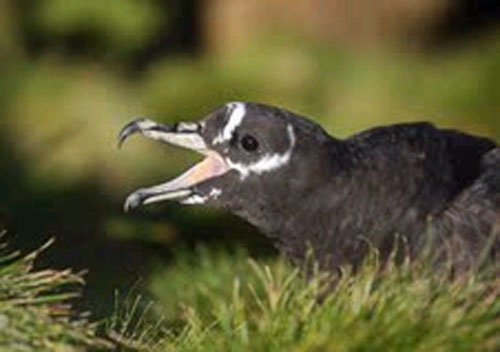The Fluttering Shearwater Puffinus gavia is endemic to New Zealand and has recently been in the news because an unknown number were oiled by the Rena disaster, although at least 198 oiled corpses were found (click here).
Helen Gummer and Lynn Adams report in a 2010 publication by New Zealand's Department of Conservation that 225 Fluttering Shearwater chicks were transferred from Long Island across the Cook Strait to the Mana Island Scientific Reserve during 2006-2008. The project follows on from previous successful efforts to establish Common Diving Petrels Pelecanoides urinatrix and Fairy Prions Pachyptila turtur on the island in an attempt to restore an ecosystem influenced by burrow-nesting seabird activity. At least 191 chicks (85%) were presumed to have fledged successfully in good enough condition to survive post-fledging. The publication describes the selection of chicks, transfer methods and hand-feeding protocols; and presents emergent behaviour, fledging results and a summary of the success of the translocation.
Translocation of chicks to former and to new breeding localities is increasingly becoming a valuable conservation option for burrow-nesting seabirds. Less effort so far has been put into translocating chicks of surface-nesting procellariiform seabirds, such as those listed by ACAP. However, pioneer efforts are being made in the North Pacific with albatrosses, notably with the Short-tailed Albatross Phoebastria albatrus with the on-going attempt to establish a new breeding colony on Japan's Mukojima Island (click here).
It is interesting to speculate what other ACAP-listed species would benefit from translocation exercises to extinct or new breeding sites: for example Tristan Albatross Diomedea dabbenena back to Tristan da Cunha or the Spectacled Petrel Procellaria conspicillata to Amsterdam Island. Maybe one day...

Spectacled Petrel on Inaccessible Island: could it be reintroduced to Amsterdam Island?
Photograph by Peter Ryan
Visit the Friends of Mana Island to learn more about restoration efforts on the island and click here to read the good news that a recent rat sighting on the hitherto rat-free island has led to the animal taking poison bait and is thus considered to have died.
Selected References:
Deguchi, T., Jacobs, J., Harada, T., Perriman, L., Watanabe, Y., Sato, F., Nakamura, N., Ozaki, K. & Balogh, G. 2011. Translocation and hand-rearing techniques for establishing a colony of threatened albatross. Bird Conservation International. doi: 10.1017/S0959270911000438.
Gummer, H. 2003. Chick translocation as a method of establishing new surface-nesting seabird colonies: a review. DOC Science Internal Series No. 150. Wellington: Department of Conservation. 40 pp.
Gummer, H. & Adams, L. 2010. Translocation Techniques for Fluttering Shearwaters (Puffinus gavia): Establishing a Colony on Mana Island, New Zealand. Wellington: Department of Conservation. 52 pp.
Miskelly, C.M. 1999. Mana Island Ecological Restoration Plan. Wellington: Department of Conservation. 149 pp.
Miskelly, C.[M.] 2010. Mana Island Ecological Restoration Plan Review. Wellington: Department of Conservation. 45 pp.
Miskelly, C.M., Taylor, G.A., Gummer, H. & Williams, R. 2009. Translocations of eight species of burrow-nesting seabirds (genera Pterodroma, Pelecanoides, Pachyptila and Puffinus: Family Procellariidae). Biological Conservation 142: 1965-1980.
John Cooper, ACAP Information Officer, 2 January 2012

 English
English  Français
Français  Español
Español